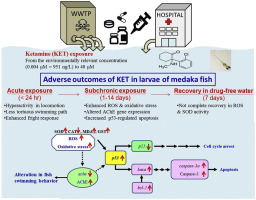Environmental Pollution ( IF 7.6 ) Pub Date : 2017-11-14 , DOI: 10.1016/j.envpol.2017.11.026 Pei-Han Liao , Wen-Kai Yang , Ching-Hsin Yang , Chun-Hon Lin , Chin-Chu Hwang , Pei-Jen Chen

|
With increasing problems of drug abuse worldwide, aquatic ecosystems are contaminated by human pharmaceuticals from the discharge of hospital or municipal effluent. However, ecotoxicity data and related toxic mechanism for neuroactive controlled or illicit drugs are still lacking, so assessing the associated hazardous risk is difficult. This study aims to investigate the behavioral changes, oxidative stress, gene expression and neurotoxic or apoptosis effect(s) in larvae of medaka fish (Oryzias latipes) with environmentally relevant exposures of ketamine (KET) solutions for 1–14 days. KET exposure at an environmentally relevant concentration (0.004 μM) to 40 μM conferred specific patterns in larval swimming behavior during 24 h. At 14 days, such exposure induced dose- and/or time-dependent alteration on reactive oxygen species induction, the activity of antioxidants catalase and superoxide dismutase, glutathione S-transferase and malondialdehyde contents in fish bodies. KET-induced oxidative stress disrupted the expression of acetylcholinesterase and p53-regulated apoptosis pathways and increased caspase expression in medaka larvae. The toxic responses of medaka larvae, in terms of chemical effects, were qualitatively analogous to those of zebrafish and mammals. Our results implicate a toxicological impact of waterborne KET on fish development and human health, for potential ecological risks of directly releasing neuroactive drugs-containing wastewater into the aquatic environment.
中文翻译:

非法药物氯胺酮在环境相关的暴露下,诱发行为改变和氧化应激对鱼中p53调控的细胞凋亡的不利影响
随着世界范围内药物滥用问题的日益严重,水生生态系统受到医院或市政污水排放中人类药物的污染。但是,仍然缺乏用于神经活性控制或非法药物的生态毒性数据和相关的毒性机制,因此很难评估相关的危险性。本研究旨在调查的行为变化,氧化应激,基因表达和神经毒性或青鳉鱼幼虫凋亡的影响(S)(青鳉)与氯胺酮(KET)溶液的环境相关暴露1到14天。在环境相关浓度(0.004μM)至40μM下的KET暴露在24小时内赋予幼虫游泳行为特定的模式。在第14天,这种暴露引起了对活性氧的诱导,剂量和/或时间依赖性的变化,抗氧化剂过氧化氢酶和超氧化物歧化酶的活性,谷胱甘肽S-转移酶和鱼体内丙二醛含量的变化。KET诱导的氧化应激破坏了aka高幼虫中的乙酰胆碱酯酶的表达和p53调控的凋亡途径,并增加了caspase的表达。就化学作用而言,高幼虫的毒性反应在质量上类似于斑马鱼和哺乳动物的毒性反应。











































 京公网安备 11010802027423号
京公网安备 11010802027423号